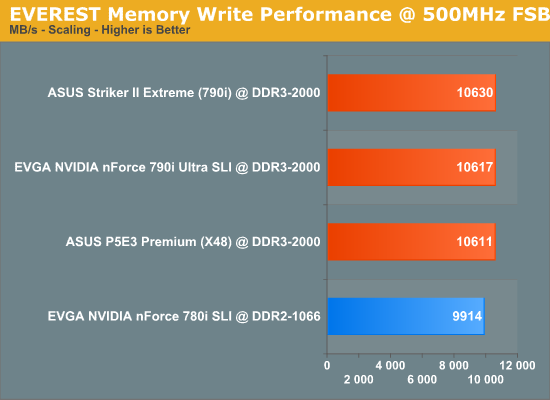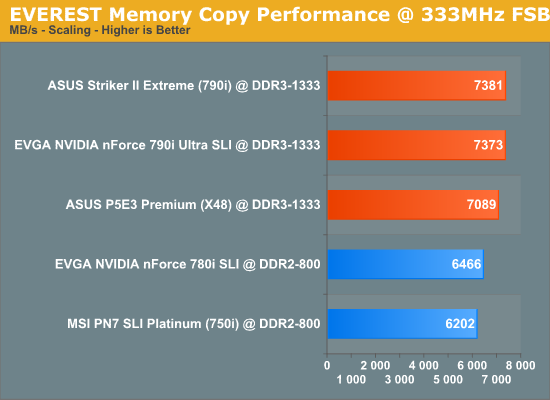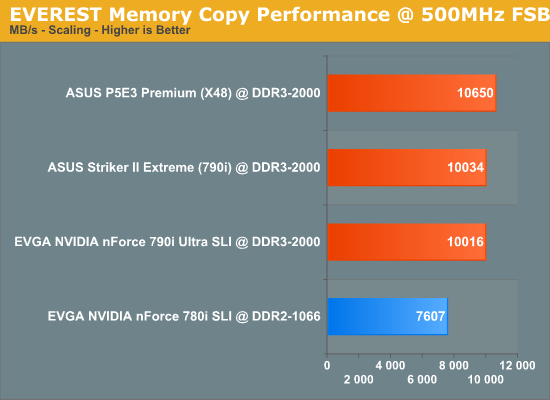ASUS Striker II Extreme: Mucho Bang, Mucho Bucks
by Kris Boughton on April 11, 2008 7:00 AM EST- Posted in
- Motherboards
Memory Write and Copy Performance

Memory write performance is almost solely dependent on FSB, although changes in absolute CAS latency can have a much smaller secondary affect. There is no clock crossing procedure needed when moving data across the FSB onto the memory bus during write operations; therefore total memory throughput is based largely on the speed of the interface and nothing more. DDR3 shows improvements over DDR2 in this regard.

The trend carries on through 400MHz FSB where a 20% increase in FSB leads to an equivalent 20% increase in memory write performance.

Each of the DDR3 boards continues scaling to 500MHz FSB with the expected 25% jump in memory write performance over 400MHz FSB. However, the DDR2-based 780i board stalled at just under 10GB/s signifying a rather serious problem with memory writes with this board. Whatever the problem was NVIDIA has obviously implemented the fix in 790i.

Memory copy benchmarks are unique in that they provide a great indication of just how well a memory controller balances the importance of read versus write requests. A chipset certainly cannot facilitate good copy speeds if read or write performance is low. The memory controller must first read the data from memory before it can write it back to memory (this is basis of a copy operation) and a bottleneck with either can bring everything to a crawl. Naturally, the DDR3 boards have an advantage in read performance at equivalent clock speeds and easily outclass the DDR2 boards.
To our surprise memory copy performance sometimes actually exceeded memory write speeds for the same FSB - in this case the 790i showed unexpected efficiency. A possible explanation for this phenomenon is the manner in which memory write requests are sometimes internally queued by the MCH until a lapse in memory read requests provides opportunity for a quick burst of write data to be sent across the memory bus, unimpeded by competing traffic.
In this respect, bandwidth as measured from the viewpoint of total memory throughput would be higher. Although the time to complete the pending write request might suffer, most writes are highly asynchronous - there would be little need for an instantaneous write operation unless an immediate read request depended on data stored by the same write to memory. In that case the controller could recognize this condition and simply read the data from the "cache line" without even touching main memory. You could almost argue that the MCH provided the functionality indicative of a highly specialized L3 cache in this particular situation.

We see here the roles reversed with the X48 Express chipset showing better memory copy performance than both 790i-based boards.

The Intel X48 Express wins again at 500MHz FSB, an oddity considering the commanding lead held by 790i when it comes to memory read performance at this system bus speed. We are tempted to give Intel's X48 the nod for the win, seeing as how it either wins or ties 790i in three out of four tests (memory access latency, memory write performance, and memory copy performance).










23 Comments
View All Comments
takumsawsherman - Saturday, April 12, 2008 - link
But for $400, you only get Firewire 400. Is that like a key, or something? If we pay $800 for a board, will they finally feel as though they can afford to add Firewire800, as Gigabyte did on their $200 boards like 3 or 4 years ago?When they talk about adding firewire itself to a board, does it never occur to them that a faster variation has existed for 5 or 6 years now? How insulting.
Grandpa - Saturday, April 12, 2008 - link
It doesn't matter what the price, performance, make, or model. If the board is unstable I don't want it! I had an Abit board once with a VIA chipset. It corrupted data when large files were transferred between drives. Several BIOS updates later, with the performance down to a crawl, it still corrupted data. Because of that ugly bad memory, stability is number one important for me. So this review is very relevant to others like myself.Super Nade - Friday, April 11, 2008 - link
As far as I know, the capacitors you mention are made by Fujitsu's Media division (FP-Cap series), not Fairchild semiconductor. Fujitsu did try to gobble up Fairchild in the 80's, but the US government killed the deal. Apart from this, I am not aware of any connection between these two companies.Here is the link--> http://jp.fujitsu.com/group/fmd/en/services/capaci...">http://jp.fujitsu.com/group/fmd/en/services/capaci...
S-N
Stele - Saturday, April 12, 2008 - link
Super Nade's right. The vendor marking on the capacitors - which have been the same for almost all such solid electrolytic polymer caps used on Asus boards for some time now - is very much that of Fujitsu: a letter 'F' in Courier-esque font between two horizontal lines.Interestingly - and confusingly - however, once upon a time this logo was indeed that of Fairchild Semiconductor... the deal that almost happened in the 80s may have something to do with Fujitsu's current use of the said logo. Either way, Faichild Semi have long since changed to their current logo (a stylised italic 'f') so today, any current/new electronic/semiconductor component carrying the F-between-bars logo is almost certainly a Fujitsu product.
jojo29 - Friday, April 11, 2008 - link
Just wondering how the Anandtech's Choice P5E3 Premium ( which i plan on buying) stacks up against this Striker? Any comments? Or did i miss something in the aricle as i was only able to skim through it, as im at work atm, and dontcoughwantcoughtogetcaughtbymybosscough...kjboughton - Friday, April 11, 2008 - link
We used one X48 motherboard in this review and it was the ASUS P5E3 Premium. Enjoy the full read when you make it home. ;)ImmortalZ - Friday, April 11, 2008 - link
You mention that overclocking the PCI-E bus provided tangible performance benefits on the EVGA board.Did you read about the rumblings around the net about some G92 based cards overclocking their GPU with the PCI-E bus? There are supposedly two clock sources for these type of cards - one on board and the other slaved to the PCI-E bus.
Are you sure that the performance improvement is not because of this anomaly?
CrystalBay - Friday, April 11, 2008 - link
Hi Kris, while UT3 does scale very well with multi-core. The game it self has no DX10 support as of yet. Hopefully EPIC will will enable it in a future update...Glenn - Friday, April 11, 2008 - link
All the benchies and comparisons are great, but how does it compare to a P35 board? A 965 or X38 board? I doubt you will convert those that already own an X48 and I (P35) have no point of reference within this article to see if I'm 5, 10 or 25% behind the preformance curve?Rolphus - Friday, April 11, 2008 - link
Interesting review... only one question though. Why use the 32-bit version of Crysis on Vista x64? Is there an issue with the 64-bit version that I don't know about?